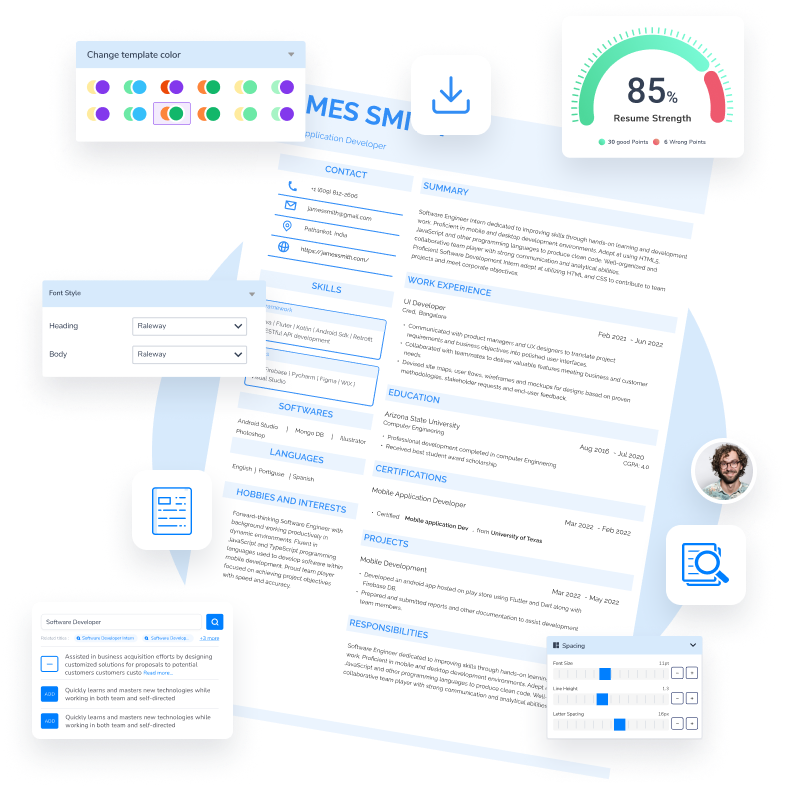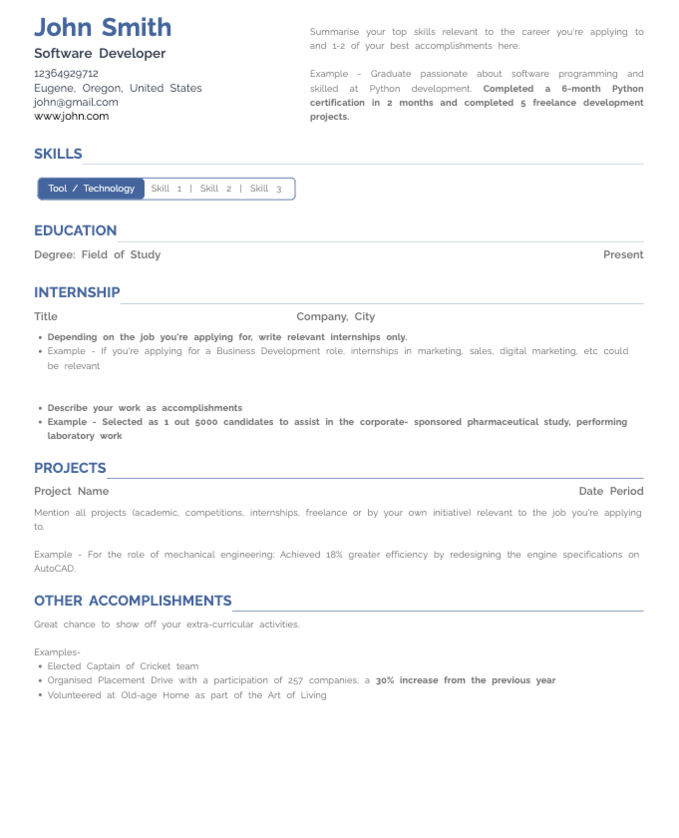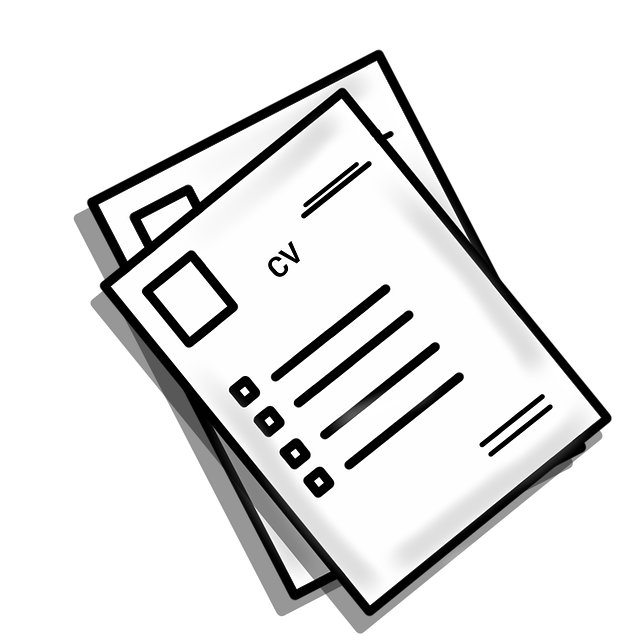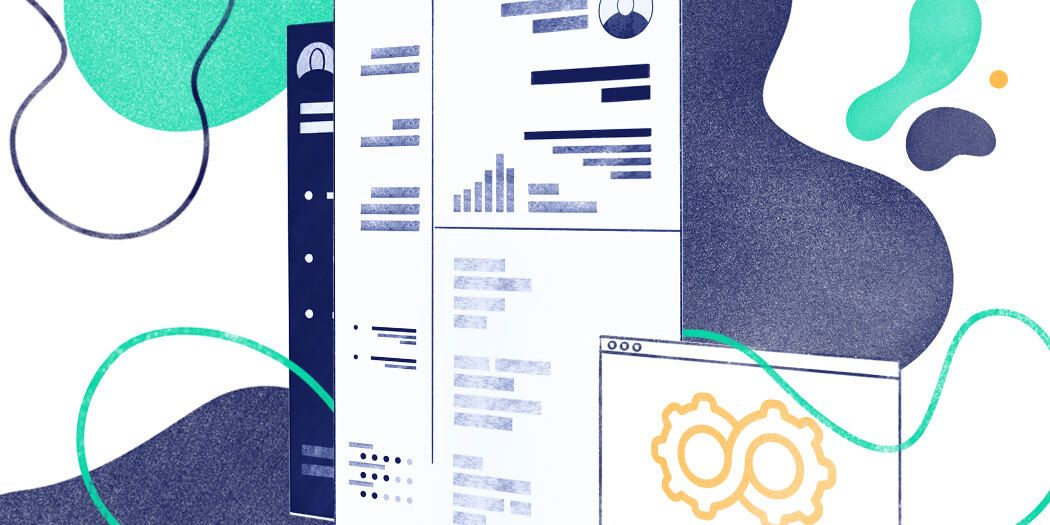10+ Tips & Tricks to Build a Resume For Engineering Graduates
7 min read

How to get a job after engineering?
This question will haunt you in your last year of engineering.
However, you must remember that you're in a professional degree course that will open the doors to many job opportunities after completion.
To get a job after engineering, you only need a job-winning resume. Considering this fact, we are here to answer some fundamental resume-crafting questions:
- How to choose a suitable resume format for engineering graduates?
- What are the essential sections in engineering resumes?
- How to write an effective summary in engineering resumes?
- How to frame an effective work experience section in engineering resumes?
- How to list educational details in an engineering resume?
The answers to these questions will help you craft an effective engineering resume without any complications. However, if there is a time shortage, we recommend trying HyreSnap Online Resume Builder.
It is a powerful resume-building platform that can help you craft job-winning resumes with the power of artificial intelligence.
Choosing the right resume format for engineering graduates is not very complex. You can use Reverse Chronological or Combination Resume Format to craft a professional resume for engineering graduates.
In both resume formats, you need to list your resume details in reverse chronological order, with the recent ones at the top.
In engineering resumes, several essential sections need to be included to effectively showcase your skills, qualifications, and achievements. These sections help recruiters understand your engineering background and determine your suitability for the role. Here are the key sections to include in an engineering resume:
Contact Information
Provide your full name, address, phone number, and professional email address. Make sure this information is easily accessible at the top of your resume.
Resume Summary or Objective
A brief and concise summary or objective statement that highlights your engineering background, key skills, and career goals. Tailor this section to match the specific job you're applying for.
Education
List your educational qualifications, starting with your most recent degree. Include the name of the university, degree earned, graduation date, and any relevant coursework or academic achievements.
Technical Skills
Showcase your technical skills and engineering expertise. This may include programming languages, software proficiency (e.g., CAD tools, simulation software), equipment handling, and any other specific engineering skills.
Work Experience
Detail your work history in reverse-chronological order, starting with your most recent job. Include job titles, company names, employment dates, and a description of your roles and responsibilities. Focus on engineering-related tasks and any notable accomplishments.
Engineering Projects
Highlight significant engineering projects you've completed during your studies, internships, or personal projects. Describe the projects, your role, the technologies used, and the outcomes or results achieved.
Certifications and Training
List any relevant certifications or training programs you've completed in the engineering field. This could include professional certifications or workshops related to specific engineering skills.
Awards and Achievements
Include any academic or engineering-related awards or recognitions you've received. This section helps demonstrate your dedication and expertise in the engineering field.
Professional Memberships
If you are a member of any engineering-related professional organisations or associations, mention them in this section.
Extracurricular Activities
Include any engineering-related extracurricular activities or volunteer work you've participated in. This can showcase your passion for engineering and your ability to work in a team.
Publications or Research
If you have authored or co-authored any engineering-related publications or conducted research, mention them in this section.
References
Including references on your resume is unnecessary, but you can state, "References available upon request."
Writing a compelling Profile Summary in engineering resumes is essential as it serves as your introduction to potential employers and highlights your key skills and qualifications.
Here's how to write an effective Profile Summary for an engineering resume:
Keep It Concise
Keep your Profile Summary brief and to the point. Aim for 3-4 sentences or 3-5 bullet points. Avoid lengthy paragraphs that may be overwhelming for recruiters.
Include Your Engineering Specialisation
Begin by mentioning your engineering specialisation or focus area. This helps recruiters immediately understand your expertise.
Highlight Your Engineering Experience
Briefly mention your years of experience in engineering and any notable roles or positions you've held.
Emphasise Key Skills and Expertise
Highlight your core engineering skills and expertise. Focus on technical skills specific to your engineering field, such as software proficiency, programming languages, equipment handling, design capabilities, etc.
Showcase Engineering Achievements
Include any significant engineering accomplishments, such as successful project completions, cost-saving initiatives, innovative designs, or patents.
Mention Your Problem-Solving Abilities
Highlight your problem-solving and analytical skills. Emphasise your ability to analyse complex engineering challenges and develop effective solutions.
Incorporate Industry Keywords
Incorporate relevant industry-specific keywords and terminologies related to your engineering specialisation. This can make your Profile Summary more appealing to applicant tracking systems (ATS) used by many employers.
Customise for Each Job Application
Customise your Profile Summary for each engineering job application. Tailor the content to match the specific requirements of the role you're applying for.
Example Profile Summary for a Mechanical Engineer:
"Mechanical Engineer with 5 years of experience in product design and development. Proficient in CAD software and finite element analysis. Skilled in optimising mechanical systems and improving product performance. Recognised for leading a cross-functional team in successfully launching three new product lines. Strong problem-solving abilities with a track record of reducing production costs by 20% through design improvements. Eager to leverage my engineering expertise and innovative mindset to drive engineering excellence at [Company Name]."
Example Profile Summary for a Software Engineer:
"Highly motivated Software Engineer with a focus on web application development. Proficient in Java, JavaScript, and React. Experienced in designing and implementing scalable software solutions. Demonstrated expertise in full-stack development, from database design to front-end user interface. Recognised for leading a team in developing an award-winning e-commerce platform. Strong problem-solving skills and a passion for writing clean, efficient code. Excited to contribute my technical skills and creativity to drive software innovation at [Company Name]."
Framing the Work Experience section for engineering resumes requires a strategic presentation of your engineering roles, responsibilities, and achievements. Follow these steps to effectively showcase your engineering work experience:
- Use Reverse-Chronological Order: Start with your most recent or current engineering position and work backwards in time. This format allows recruiters to see your recent engineering experience first.
- Provide Essential Information: For each engineering role, include the job title, company name, location, and employment dates. This information provides context to your work history.
- Use Strong Action Verbs: Begin each bullet point describing your engineering responsibilities and achievements with strong action verbs. Words like "led," "designed," "implemented," "managed," "optimised," and "achieved" make your experience sound more impactful.
- Quantify Your Achievements: Quantify your engineering accomplishments using specific metrics and numbers. Highlight results such as project outcomes, cost savings, efficiency improvements, or successful product launches.
- Focus on Engineering-Related Tasks: Emphasise your engineering-specific roles and responsibilities. Highlight your contributions to engineering projects, technical expertise, problem-solving skills, and any unique engineering challenges you tackled.
- Include Technical Skills: Mention technical skills relevant to your engineering field, such as programming languages, software proficiency (e.g., CAD tools, simulations), and engineering methodologies you utilised.
- Demonstrate Collaboration: Showcase your ability to work in a team environment. Describe any cross-functional collaborations or contributions to interdisciplinary engineering projects.
- Highlight Engineering Projects: If applicable, include significant engineering projects you've worked on during your roles. Mention your role in the project, the technologies used, and the results achieved.
- Showcase Leadership (if applicable): If you hold any leadership roles, such as project manager or team leader, emphasise your ability to guide and manage engineering teams.
- Be Concise and Clear: Keep your bullet points concise, and avoid using jargon that may not be familiar to all readers. Use clear and straightforward language to communicate your engineering accomplishments effectively.
Example (with quantifiable achievements):
Mechanical Design Engineer | XYZ Engineering Solutions | [Dates]
- Led a team of 5 engineers in the successful design and development of a new product, resulting in a 30% increase in revenue within the first year of its launch.
- Improved the efficiency of a manufacturing process by implementing new design modifications, reducing production costs by 25%.
- Conducted finite element analysis (FEA) on critical components, resulting in a 15% increase in product reliability and a 20% reduction in maintenance costs.
- Designed and implemented a new heat exchanger system, leading to a 40% improvement in energy efficiency and a reduction in carbon emissions by 25%.
Listing education in engineering resumes is essential to showcase your academic qualifications and technical expertise.
Here's how to effectively list your education:
Placement
Place the "Education" section after the "Work Experience" section on your resume. However, if you are an entry-level engineering graduate with limited work experience, you can place the "Education" section before the "Work Experience" section.
Format
List your educational details in reverse-chronological order, starting with your most recent degree or certification.
Include Relevant Information
Add the following information to this section for making it more impactful:
- Degree and Major: Mention your degree (e.g., Bachelor of Science in Mechanical Engineering) and your major or specialisation.
- University/Institution: Include the name of the university or institution where you earned your degree.
- Graduation Date: Provide the month and year of your graduation or the expected graduation date if you are currently pursuing the degree.
Honours and Distinctions
If you graduated with honours or received any academic distinctions, you can mention them in parentheses after your degree (e.g., Bachelor of Engineering in Electrical Engineering (Summa Cum Laude)).
Relevant Coursework (Optional)
For recent graduates or students seeking internships, you can include relevant coursework related to your engineering field to showcase your knowledge in specific areas.
GPA (Optional)
If you have a strong GPA (3.5 or above) and are an entry-level candidate, you can include it in your education section. However, it is not mandatory and can be left out.
Example:
Education:
Bachelor of Science in Mechanical Engineering
ABC University, City, State
Graduated: May 2023
Relevant Coursework: Thermodynamics, Fluid Mechanics, Strength of Materials, Mechanical Design.
Master of Engineering in Electrical Engineering
XYZ Institute of Technology, City, State
Expected Graduation: December 2023
Relevant Coursework: Power Systems, Control Systems, Electronics, Digital Signal Processing.
To help you present your engineering resume effectively, we are listing a sample resume for computer engineering below.
You can refer to this sample while building your engineering resume to avoid confusion and complications.
Sample Resume For Engineering Graduates:
Arvind Gupta
Email- arvind.gupta@gmail.com
Phone- +919283740251
LinkedIn- https://www.linkedin.com/in/arvind-gupta/
Summary:
Highly skilled and motivated Software Engineer with a passion for problem-solving and a strong background in full-stack web development. Proficient in JavaScript, React, Node.js, and SQL. Experienced in designing and implementing scalable and efficient software solutions. Dedicated to continuous learning and staying up-to-date with the latest technologies. Excellent team player with effective communication and collaboration skills.
Technical Skills:
- Programming Languages: JavaScript, HTML, CSS, Python
- Front-end Development: React, Redux, jQuery, Bootstrap
- Back-end Development: Node.js, Express, Django
- Database Management: SQL, MongoDB
- Version Control: Git
- Tools: Visual Studio Code, Sublime Text, Postman
- Operating Systems: Windows, Linux
Projects:
E-commerce Website
- Developed a fully functional e-commerce website using React for the front end and Node.js with Express for the back end.
- Integrated a secure payment gateway and implemented user authentication and authorisation features.
- Designed and implemented the product catalogue, shopping cart, and order processing system.
Social Media Analyzer
- Created a web application that analyses social media data using Python and Django.
- Implemented sentiment analysis, word frequency, and user engagement metrics for social media posts.
- Visualised the data using charts and graphs for easy interpretation.
Work Experience:
Software Engineer Intern | ABC Tech Solutions | [Dates]
- Collaborated with the development team to design and implement new features for web applications.
- Participated in code reviews and provided constructive feedback to improve code quality.
- Assisted in debugging and troubleshooting software issues, ensuring smooth product performance.
Software Development Intern | XYZ Software | [Dates]
- Worked with the software development team to develop and test new software products.
- Assisted in documenting software specifications and user manuals.
- Conducted research on emerging technologies to contribute to product improvement.
Education:
Bachelor of Science in Computer Science
XYZ University, City, State
Graduated: May 2022
Relevant Coursework: Data Structures, Algorithms, Web Development, Database Management.
Certifications:
- [List any relevant certifications related to software development]
Languages:
- English (Fluent)
- Hindi (Native)
References:
Available upon request.
A cover letter is not always required with engineering resumes, but it can be a valuable addition to your job application. Including a well-crafted cover letter can help you stand out from other candidates and provide more context about your skills and experiences.
Here are some situations when you should consider including a cover letter with your engineering resume:
- When the Job Posting Requests One: If the job posting specifically asks for a cover letter along with your resume, submitting one is essential, as failing to do so might be seen as not following instructions.
- To Explain Your Motivation: A cover letter allows you to explain why you are interested in the position and the company. You can highlight your enthusiasm for the engineering field and demonstrate your understanding of the company's goals and values.
- To Address Specific Qualifications: If you want to emphasise certain qualifications that may not be immediately evident in your resume, a cover letter allows you to do so. You can discuss specific engineering projects, coursework, or experiences that align with the job requirements.
- To Showcase Your Communication Skills: Effective communication is crucial as an engineer. A well-written cover letter can demonstrate your ability to convey information clearly and professionally.
- To Address Employment Gaps or Career Changes: If you have employment gaps or are transitioning into a new engineering field, a cover letter allows you to address these situations and provide context for potential employers.
- To Express Your Fit for the Company Culture: You can use the cover letter to explain why you believe you would be a good fit for the company's culture and values. This personal touch can make a positive impression on recruiters.
You can start building your resume for team leader jobs by following the above mentioned steps. However, if you do not want to get involved in this hectic and time-consuming process, try HyreSnap Online Resume Builder.
It is an effective resume-building platform that can help you frame an impeccable team leader resume in easy steps. Below you can see a list of features offered by this 21st-century free resume builder:
In this guide, we have listed all the essential guidelines to build a technically strong and ATS-friendly team leader resume. For instance, you can check the key takeaways below:
- Outline your resume based on the resume format you choose
- Write your work experience in one-liner bullet points for better readability
- Write your resume summary after completing your team leader resume
- Add keywords and highlight key information wherever possible
- List your key and technical skills separately for an organised presentation
- Take a pause after completing your resume, then proofread it to rectify errors
For more details and additional career-building assistance, contact our career experts at info@hyresnap.com. You will get every possible help from our end to build a bright career in 2023.

Try Now for Free!



